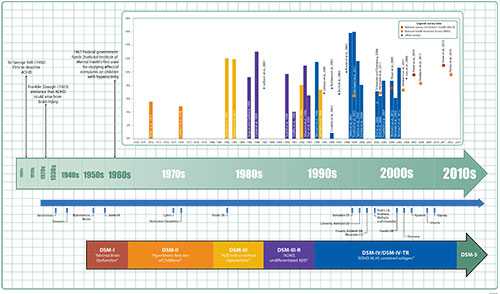ADHD Throughout the Years
The percent of children estimated to have ADHD has changed over time. A historical view provides necessary context to understand changes in the epidemiology of ADHD.
The timeline below shows
- Estimates across the years for the percent of children in the United States with ADHD.
- How the criteria used to diagnose the condition have changed over time.
- The approval of medication treatments by the Food and Drug Administration (FDA) beginning with Benzedrine in 1936.
Estimates for the percent of children in the population who have ADHD vary widely across time. The difference in these numbers is likely based on variations in how the diagnostic criteria were applied. In addition, there may have been some differences in the demographic characteristics of the samples used to calculate the estimates. It is also possible that the samples were exposed to factors that affect ADHD, but until more is known about these factors, it is not possible to know whether they explain some of the variation.
The first national survey that asked parents about ADHD was completed in 1997. Since that time, there has been a clear upward trend in national estimates of parent-reported ADHD diagnoses. It is not possible to tell whether this increase represents a change in the number of children who have ADHD, or a change in the number of children who were diagnosed. Perhaps relatedly, the number of FDA-approved ADHD medications increased noticeably since the 1990s, after the introduction of long-acting formulations.
Timeline of ADHD diagnostic criteria, prevalence, and treatment
View and print larger version »

- Page last reviewed: September 5, 2017
- Page last updated: February 7, 2017
- Content source:


 ShareCompartir
ShareCompartir